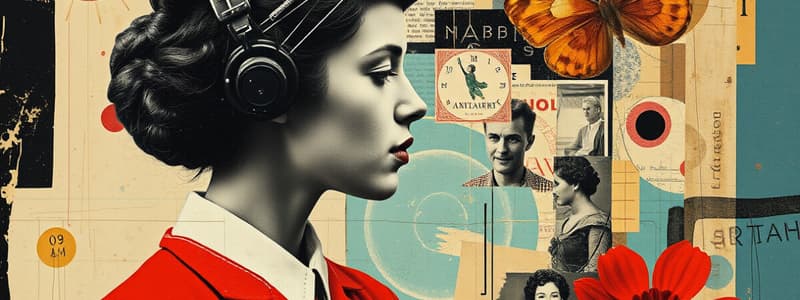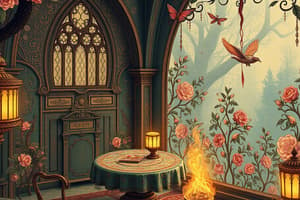Podcast
Questions and Answers
What are complementary colors commonly used for in children's cereals?
What are complementary colors commonly used for in children's cereals?
- To blend in with the packaging
- To create a monochromatic scheme
- To attract attention (correct)
- To establish a calming effect
Which of the following best defines achromatic colors?
Which of the following best defines achromatic colors?
- Colors that consist solely of bright, warm tones
- Colors that lack hue and include only white, black, and grey (correct)
- Colors that include tints of other colors
- Colors that combine primary colors and their neighbors
What happens to a color when white is added to it?
What happens to a color when white is added to it?
- The color becomes a tint (correct)
- The color remains unchanged
- The color becomes a tone
- The color becomes a shade
What effect does linear perspective create in an artwork?
What effect does linear perspective create in an artwork?
Which type of color scheme uses a hue and its neighbors on the color wheel?
Which type of color scheme uses a hue and its neighbors on the color wheel?
What is the result of adding black to a color?
What is the result of adding black to a color?
How does atmospheric perspective affect the perception of objects in a painting?
How does atmospheric perspective affect the perception of objects in a painting?
In terms of space in art, what does 'real space' refer to?
In terms of space in art, what does 'real space' refer to?
What is the definition of real texture in visual art?
What is the definition of real texture in visual art?
Which of the following best describes complementary colors?
Which of the following best describes complementary colors?
What effect can color have on an observer according to psychological studies?
What effect can color have on an observer according to psychological studies?
Which technique is associated with the creation of literal or tactile texture in art?
Which technique is associated with the creation of literal or tactile texture in art?
What are intermediate or tertiary colors?
What are intermediate or tertiary colors?
What is a fundamental aspect that lines can convey in art?
What is a fundamental aspect that lines can convey in art?
Which type of line is typically associated with comfort and ease?
Which type of line is typically associated with comfort and ease?
What do broken lines in art typically express?
What do broken lines in art typically express?
Which element of art is required in every sculpture?
Which element of art is required in every sculpture?
In terms of line quality, which implies rigid control in artwork?
In terms of line quality, which implies rigid control in artwork?
Which element does NOT belong to the seven elements of art?
Which element does NOT belong to the seven elements of art?
What is an outline in the context of art lines?
What is an outline in the context of art lines?
Which pair of elements can provide an illusion of three-dimensionality in two-dimensional works?
Which pair of elements can provide an illusion of three-dimensionality in two-dimensional works?
Which visual element is most likely to suggest height and strength?
Which visual element is most likely to suggest height and strength?
What type of lines are generally used to lead the viewer's eye in a specific direction?
What type of lines are generally used to lead the viewer's eye in a specific direction?
What is the primary difference between shape and form in art?
What is the primary difference between shape and form in art?
How does tone contribute to the perception of three-dimensionality in art?
How does tone contribute to the perception of three-dimensionality in art?
What defines a positive shape within the context of art?
What defines a positive shape within the context of art?
What characterizes curved lines in art?
What characterizes curved lines in art?
What role does contrast play in visual arts?
What role does contrast play in visual arts?
Which of the following best describes texture in art?
Which of the following best describes texture in art?
Why is it important to have a light source when observing tone in art?
Why is it important to have a light source when observing tone in art?
What is meant by the term 'negative shape'?
What is meant by the term 'negative shape'?
What aspect of lines can be described as 'ordered movement'?
What aspect of lines can be described as 'ordered movement'?
Which characteristic differentiates geometric shapes from organic shapes?
Which characteristic differentiates geometric shapes from organic shapes?
Flashcards are hidden until you start studying
Study Notes
Colour Theory
- Children's cereals utilize complementary colours for attention-grabbing designs.
- Monochromatic colour schemes use one colour with diverse tints and shades.
- Achromatic colours lack distinct hues, consisting only of white, black, and grey, yet can offer stunning visuals with various shades of grey.
- Analogous colours are adjacent hues on the colour wheel, creating a harmonious palette (e.g., yellow and orange).
- Warm colours evoke feelings of warmth and energy, while cool colours are calming and soothing.
- Mixing white with any colour creates a "tint" (often seen as pastels); adding black or complementary colours forms a "shade."
- Adding grey to a colour produces a "tone," which softens or dulls the original hue.
Space in Art
- Real space refers to the physical area occupied by three-dimensional forms or sculptures.
- Linear perspective uses mathematical principles to create depth, characterized by diminishing size and vanishing points on a horizon line.
- Atmospheric perspective showcases how colours lose saturation and detail as they recede, creating a sense of distance.
Elements of Art
- The seven elements of art include Line, Shape, Form, Texture, Tone, Colour, and Space.
- Artists manipulate these elements together with design principles to compose artwork, although not all pieces require all elements.
Line as an Element
- A line is defined by greater length than width, can be straight, curved, horizontal, vertical, or diagonal.
- Different types of lines convey various emotions:
- Freehand lines express artist's energy and mood.
- Mechanical lines suggest rigid control.
- Continuous lines guide the viewer's eye.
- Broken lines imply ephemerality.
- Thick lines indicate strength; thin lines signify delicacy.
- Psychological responses to lines:
- Curved lines represent comfort.
- Horizontal lines evoke calmness.
- Vertical lines imply height.
- Jagged lines convey turmoil.
Shape vs. Form
- A shape is a two-dimensional area defined by boundaries, which can be geometric or organic.
- Shapes can be viewed as positive (the object) or negative (the surrounding space).
- Form, in contrast, is three-dimensional, encompassing depth in addition to length and width, and can be geometric or free-form.
Tone and Contrast
- Tone signifies changes in light and darkness, contributing to the illusion of form in three-dimensional art.
- Tone influences visual contrast, where areas closest to a light source are lightest, while those further away appear darker, enhancing dimensionality.
Texture in Art
- Texture relates to the surface quality of an object, categorizing it as real (tactile) or implied (visual).
- Real texture involves physical sensation, while implied texture creates the illusion of touch through artistic techniques.
- Artists may use methods like impasto or glazing to develop actual textures, while others, like Chuck Close, excel in creating the illusion of texture.
Understanding Colour
- Colour is essential for differentiating objects and can evoke psychological effects, influencing mood and perception.
- Primary colours—red, blue, and yellow—are the foundation for all other colours.
- Secondary colours arise from mixing primary colours:
- Red + Blue = Purple
- Red + Yellow = Orange
- Blue + Yellow = Green
- Intermediate or tertiary colours result from mixing a primary and a secondary colour.
- Complementary colours are visually opposite each other on the colour wheel and enhance one another’s vibrancy.
Studying That Suits You
Use AI to generate personalized quizzes and flashcards to suit your learning preferences.




